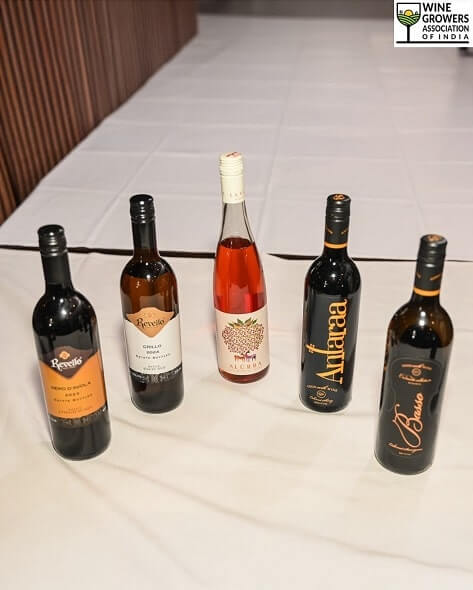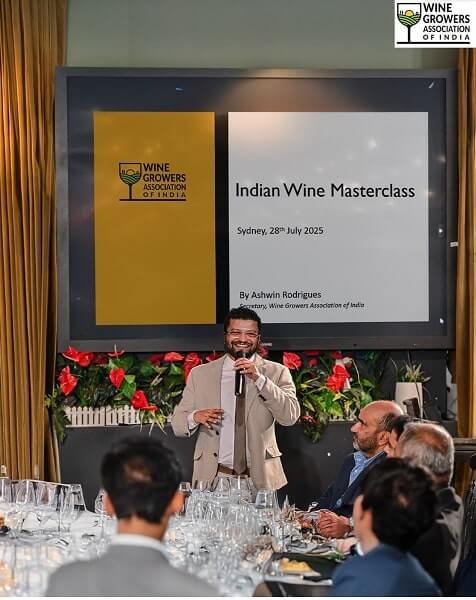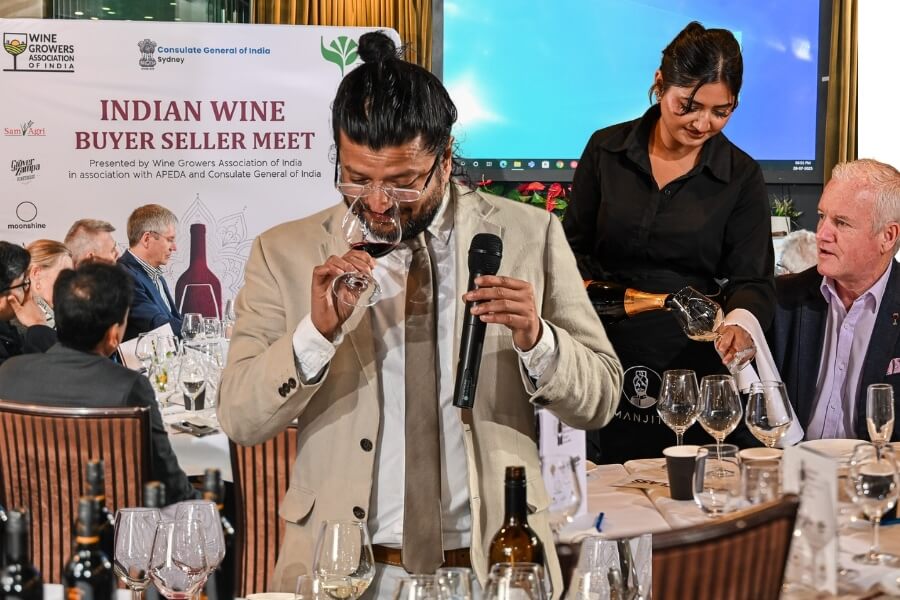Reading Time: 4 minutes
India’s emerging wine identity took centre stage in Sydney and Adelaide recently as a curated guest list of 50 Australian industry insiders – spanning importers, sommeliers, retailers, and hospitality leaders – gathered for an immersive tasting.
On offer were crisp sparklings, robust reds, aromatic meads, and innovative fruit-led pours, each glass telling a new chapter in India’s evolving viticultural voice. India’s wine industry
With a range of varietals now available in India, numerous local vineyards popping up over the past few years, and the wine scene projected to grow in the future, there is much to be excited about.
Indian wines are niche products. Despite centuries of wine consumption in the country, modern international standards classify India as an “New Emerging” market, meaning wine has only recently been introduced to the domestic market but shows great potential for success in it.

Major wine producing regions include Nashik, Pune and Bangalore, where up-and-coming producers harvest, crush and ferment everything from rosé to chardonnay to shiraz. More experimental products – like sweet strawberry wine and mead – are also being made, with bottles hitting shelves at prices tailored to middle-class families.
Introducing Indian wines to the Australian market at a wine buyer-seller meet at Sydney’s Manjit’s Wharf restaurant, the secretary of the Wine Growers Association of India Ashwin Rodrigues said, “Indian wines go well with spicy food. They have a good acidic backbone, so they cut through the fat and grease of Indian cooking.”
And he was right. India’s wine indust
The event, presented in association with the Consulate General of India and India’s Agricultural & Processed Food Products Export Development Authority (APEDA), showcased numerous drops, which were accompanied by kebab, lamb curry and non-vegetarian options.
Among some of the best wines on the night were the Reveilo Grilo, a white wine, and the Reveilo Nero D’Avola, a red. Each revealed a spirited, spicy nose that stirred the senses, unfolding into a vibrant, flavourful experience on the palate. Retailing at Rs 1200-1400, it’s easy to imagine them combined with some paneer, samosa and chutney, or chicken tikka.
 (Source: Supplied)
(Source: Supplied)
So promising is India’s wine market that Australia has elected to support it, with the two nations’ Economic Cooperation and Trade Agreement ECTA including a “Joint Dialogue on Wine”. Mutual recognition of standards, joint marketing opportunities, and technical collaboration were some of the discussions that popped up on the night.
India already imports most of its wine from Australia, but with the aid of Australian experts, the future of wine from India is promising.
“Wine brings a place to life,” said Rodrigues. “It engages all your senses. It’s tied to food, people, farmers, the soil, the weather – everything. That’s what excites me most about wine – it calls on every part of you.”
 Ashwin Rodrigues, Secretary of the Wine Growers Association of India (Source: Supplied)
Ashwin Rodrigues, Secretary of the Wine Growers Association of India (Source: Supplied)
Like other Indian winemakers, Rodrigues’ journey started from a passion. Shifting from financial services following a suggestion that he start a winery, he spent a year and a half in the Barossa Valley scrubbing tanks, sweeping floors, and hustling before bringing his viticultural knowledge back to India. Now his Good Drop Wine Cellars, based in Nashik, is one of the country’s largest wine producers.
Other producers are entering the market too; prominent names include the Sula and Grover Zampa vineyards, Alurra, Talisva Fruit Winery and SamAgri. India’s wine industry
Rodrigues believes Indian wines can capture both younger and more mature audiences.
“It’s not just traditional wine drinkers we’re selling to, but Gen Z. They’re trying out, you know, different wines, and we’re making it more approachable to them. We’re demystifying wines and it’s fun. Some of India’s sweeter alcoholic products from Moonshine are an example of that.”
Turns out, he was spot on.
The wine from Moonshine, the first meadery in India and in Asia which was launched in 2018, was different to the other drops poured that evening. Its hip bottle label and sugary taste made it feel more like a Vodka Cruiser rather than a viognier.
 (Source: Supplied)
(Source: Supplied)
While most domestic Indian wines are not currently available in Australia, Rodrigues and the Wine Growers Association hope to change that. Their wine has a contribution to make and something to say. With unique flavours and drops to suit every palette, the event showed that the “New Emerging” Indian wine market is one to watch out for. India’s wine industry
READ MORE: Pinot with Punter: Ponting and Ponting Wines at Manjit’s


Dining and Cooking